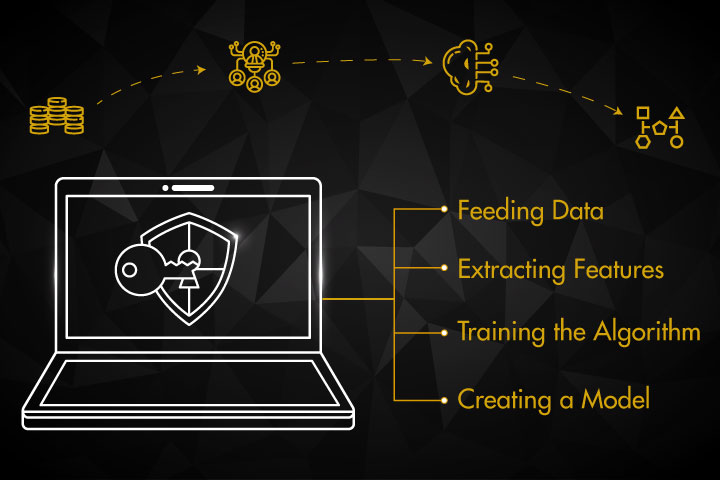
How to Utilize Machine Learning for Fraud Detection & Fraud Prevention
- Dec 23, 2019
Technology Benefits
Machine learning is now getting implementing with its highest capabilities.
What is Machine Learning?
Machine learning (ML) is the scientific study of algorithms and statistical models that computer systems use to perform a specific task without using explicit instructions, relying on patterns and inference instead.
-Wikipedia
Machine Learning is used to analyze the patterns of complex data and discover the knowledge from it.
Today, most people prefer online Softwares, eCommerce websites, Mobile Apps for shopping, business, purchasing services, and even banking purposes. Due to Digitalization and technology advancement, a number of the transaction has become very large and thus fraud detection has become painful for Banking and Finance Companies. They are struggling to authenticate the transactions.
.jpg)
There comes the power of Machine Learning.
Machine learning has always been useful for automation solutions. We are now capable to automate various works without any interference of humans.
We may get lots of other advantages in the upcoming days but there is a big buzz on the applications of machine learning in the field of fraud prevention.
We all are aware of the complex algorithms of machine learning that allow us easily to implement this technology in various fields. This technology is helping us to do various works without any worry of danger. This technology is getting utilized in the detections of payment frauds, customer frauds, and various other types of online scam activities also.
There are various advantages of utilizing machine learning along with AI to detect and prevent various types of fraud easily. In this article, we are going to discuss this topic in brief.
The fraud detection process using machine learning is a highly complex strategy. Advanced algorithms and lots of other advanced application tactics are used to implement machine learning for fraud detection work. We can easily understand the whole process of fraud detection with the help of each step included in the whole process.
Benefits of machine learning for the purpose of fraud detection?
Digital Marketing is already serving to increase the number of online customers across the globe. Thus it has become a tough task to provide the secured solutions to each customer without Data Science and Machine Learning Application.
Machine learning is able to evaluate a large number of transactions in a quick time and with a high-efficiency ratio. A large number of transactions taking place at a time through Web Applications and Mobile Applications making it more necessary to increase online security.
Process of Fraud Detection using Machine Learning
Data Collection
The fraud detection works on the basis of collected data sets. The accuracy depends on the amount of data used in the model. This helps in the proper training of the Model.
Data extraction
Extraction means the extraction of information about each related thread of every transaction process. Whenever any activity occurs in the approached systems, the data is split into three different segments i.e. testing, training, and validation.

Training Sets
The algorithms are trained to test this collected data firstly and then analyze it using various cross-validation parameters. To implement this system effectively for any type of fraud detection, it is required to make the systems prepared by collecting and analyzing huge data sets.
Building Models
Once a trained fraud detection algorithm is achieved, a model is ready, which can identify the transaction is fraudulent or non-fraudulent. It is an essential step in predicting fraud. Models are prepared to determine how to make predictions on the basis of various inputs and outputs combinations (algorithm).
What are the Techniques for Fraud Detection Algorithms?
Logistics Regression
In this, an algorithm is created by comparing the authentic transactions with fraudulent transactions. A definite set of parameters are checked and the results are given on the basis of probability calculated.
Decision Tree
In this, algorithms are trained to identify the unusual activities in a transaction from an authorized user.
Random Forest
In this, a combination of various decision trees is used. Each decision tree is to check different conditions.
Neural Networks
This concept is inspired by the human brain. It involves the use of self-learning algorithms and includes data mining, pattern recognition, etc.
ML-Based Fraud Detection Systems
The machines cannot detect the frauds unless they are taught with similar situations before. So, in these systems, we allow the machines to work with certain sets of activities that may be offensive or not allowed to occur in the real world. So, these algorithms understand those situations and become proficient in detecting those types of activities in the future.

The fast computing of machine learning will allow it to understand the patterns effectively. In the fraud detection systems, we utilize two main types of machine learnings which are as follows.
Types of Machine Learning
Supervised Learning
In supervised learning, machine learning algorithms are trained by feeding them with crucial data which may help them to become much efficient. This type of learning includes pre-learning concepts for which huge sets of data are required. So, once the machines are taught to detect certain fraud activities, it becomes easier to detect the frauds rapidly without any error. This will let the machines choose from two options which will be ‘Yes’ or ‘No’. The accuracy of these results will directly depend on how managed and effective your data is. If you teach your machines with excellent supervised learning tactics, you can make them well-prepared to detect and prevent any type of threat easily.
Unsupervised Learning
These systems are developed to detect unusual behaviors. The unsupervised learning models are based upon self-learning concepts. So, when any unwanted or new activities happens, the algorithms start learning new things and gather important information through them. It helps the machines to create patterns and keep improving them with the passing time. These systems understand the dissimilarities between different activities and make decisions to improve their performance. This is the most used system in today’s fraud detection systems.
Both of these learning models can be used separately or in a combined way to have the desired benefits.
Conclusion
Whether we implement these systems for any type of fraud prevention activity, it is ensured that we are going to receive huge benefits in the upcoming days. As the fraud activities are increasing online, the technology is coming with its best ways to tackle those frauds. This advanced fraud detection system is a big example of the advancement of technology.
Leave a Comment
Your Phone Number will not be published.





